
Полная версия
Cake: 200 fabulous foolproof baking recipes
Place the two different cake mixtures in the prepared tin by alternating heaped tablespoonfuls of the vanilla batter with the chocolate one, then, with a skewer or similar implement, gently draw swirls through the cake mixture to ‘marbleise’ it. Try not to over-mix or you won’t get that wonderful marbled effect.
Scatter the crumble mixture evenly over the top of the cake mixture and bake for 50–60 minutes or until the crumble is golden and a skewer inserted into the centre of the cake comes out clean.
Remove from the oven and allow to cool in the tin for 10 minutes, then loosen around the edges using a small, sharp knife and remove the sides of the tin. Place the cake (sitting on the base of the tin) on a wire rack and allow to cool completely.
Use a palette knife or metal fish slice to loosen the bottom of the cake from the base of the tin, then slide the palette knife or fish slice under the cake and carefully ease it onto a plate. Dust with icing sugar to serve.
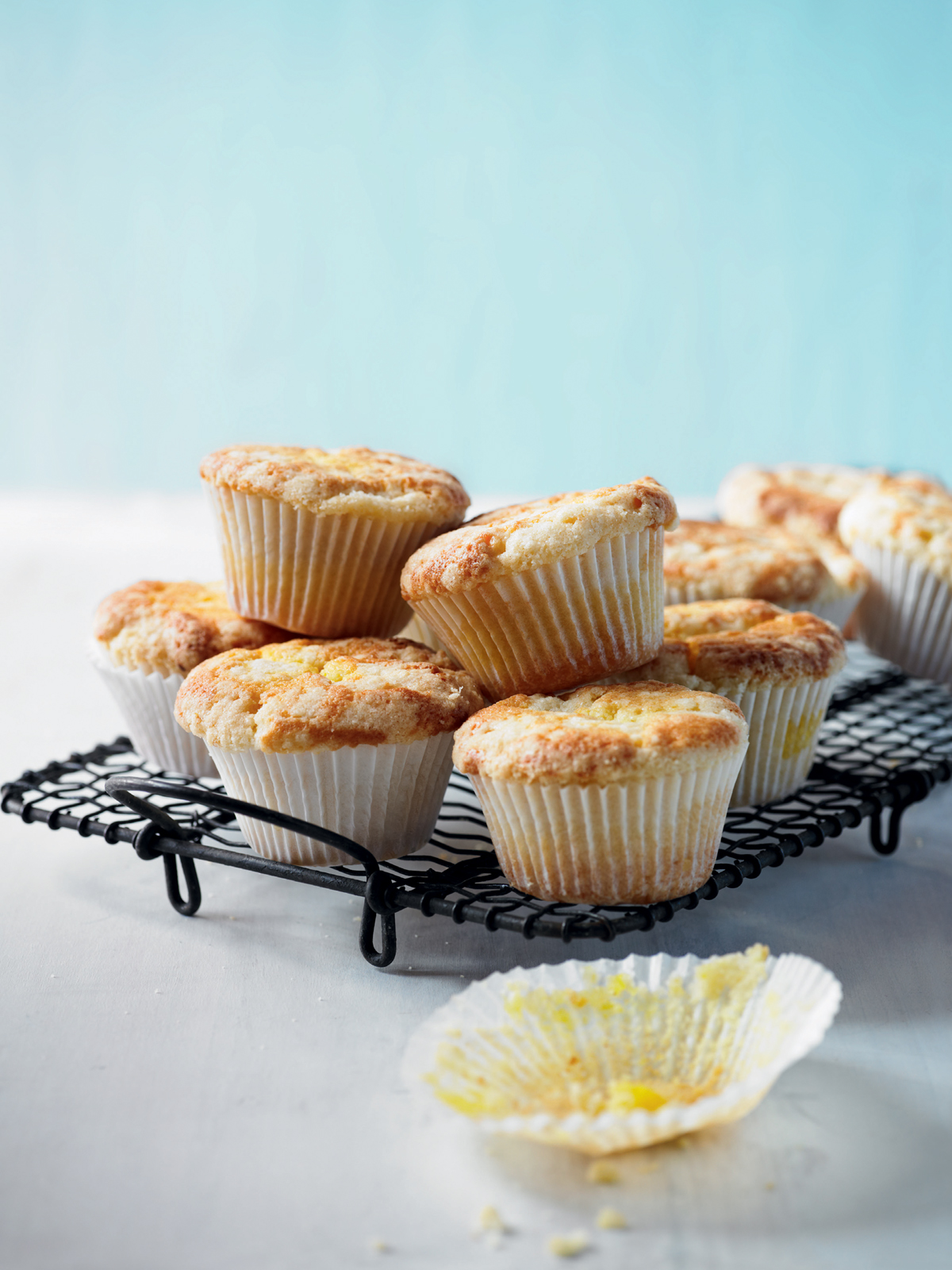
Lemon crumble cupcakes
This recipe takes lemon cupcakes to the next level. The lemon curd is easy to make – though you could use a bought variety, of course – and adds a wonderfully sweet-sharp citrus softness. The crumble topping is quick to put together, meanwhile, and adds a great contrasting crunch.
Prep time: 30 minutes (excluding the lemon curd)
Baking time: 30 minutes
Ready in: 1 hour 30 minutes
Makes: 12 cupcakes
200g (7oz) butter, softened
200g (7oz) caster sugar
4 eggs
200g (7oz) self-raising flour
Juice of 1 lemon
150g (5oz) lemon curd
For the crumble topping
75g (3oz) plain flour
75g (3oz) caster sugar
Finely grated zest of 1 lemon
100g (3½oz) butter, chilled and cut into 1cm (½in) cubes
12-cup muffin tray and 12 muffin cases
Preheat the oven to 180°C (350°F), Gas mark 4, and line the muffin tray with the paper cases.
First make the crumble topping. Sift the flour into a bowl, then add the sugar and lemon zest and mix together to combine. Use your fingertips to rub the butter into the flour until the mixture forms coarse flakes and crumbs, then set aside in the fridge until needed.
To make the cupcake batter, cream the butter in a large bowl or in an electric food mixer until soft. Add the sugar and beat until the mixture is light and fluffy.
Whisk the eggs together in a small bowl for a few seconds or just until mixed, then gradually add them to the creamed butter mixture, beating all the time. Sift in the flour and add the lemon juice, then fold in gently to incorporate.
Divide half of the batter between the muffin cases, filling each about one-third full. Add roughly ½ tablespoon of lemon curd to each paper case, so that it forms a small dollop in the middle. Then divide the other half of the batter between the cases, spooning it over the lemon curd. Finally divide the lemon crumble mixture between the cupcakes.
Bake for about 30 minutes or until nice and golden on top and lightly springy to the touch in the middle. Don’t worry if some of the curd bubbles over the top of the cupcakes while they cook.
Allow to cool for 10 minutes before removing from the muffin tray and placing on a wire rack to cool down completely.
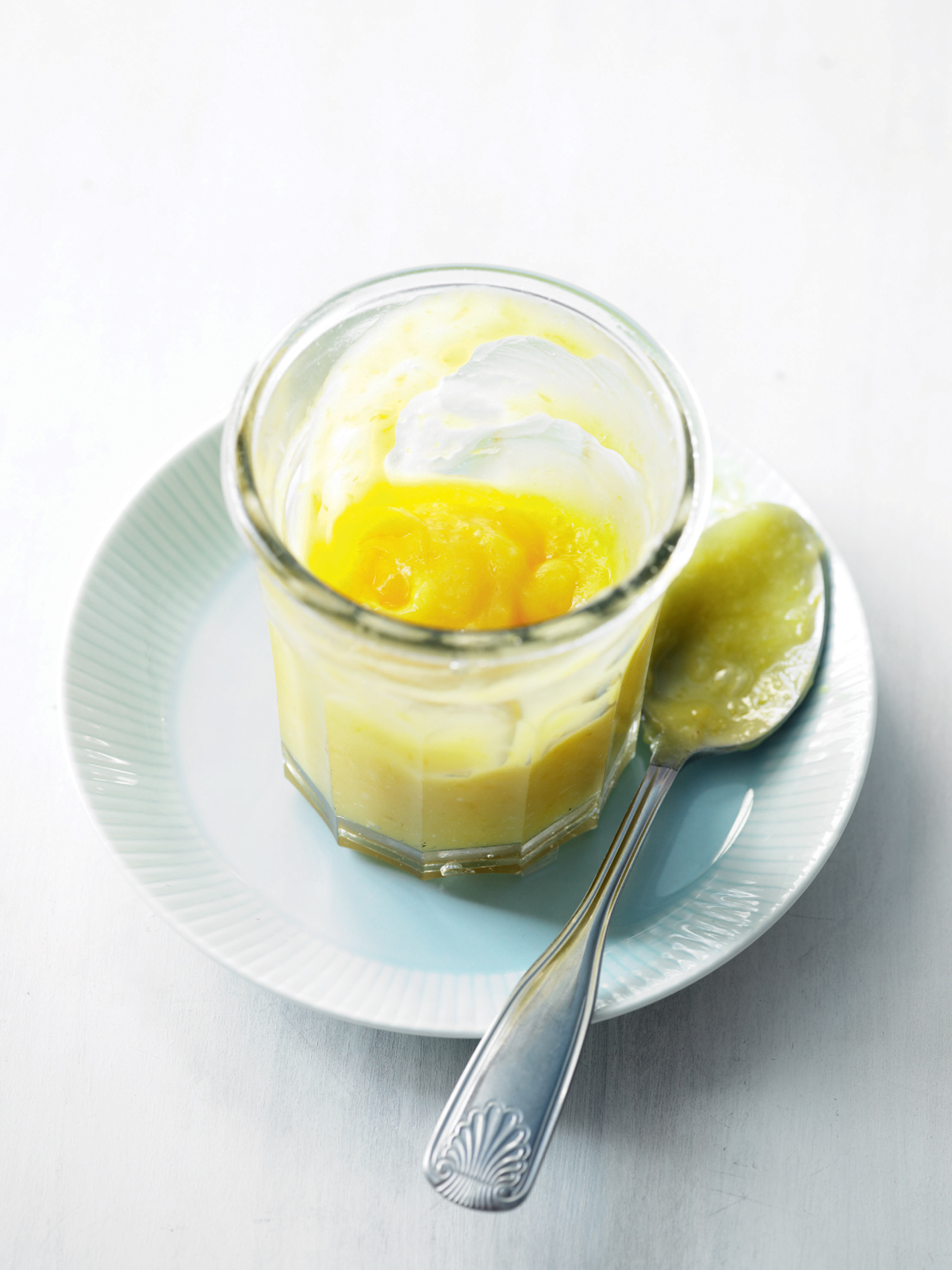
Lemon curd
Prep time: 10 minutes
Cooking time: 10 minutes
Ready in: 30 minutes
Makes: 300g (11oz)
75g (3oz) butter
150g (5oz) caster sugar
Juice and finely grated zest of 3 lemons
2 eggs
1 egg yolk
In a saucepan over a very low heat, melt the butter with the sugar, lemon zest and juice. Place the eggs and egg yolk in a bowl and beat together well, then pour into the pan.
Stir carefully over a low heat until the mixture has thickened enough to coat the back of a spoon. Take care not to let the mixture get too hot, or the eggs may scramble.
Remove from the heat and pour into a bowl or a sterilised jar (tip). The lemon curd will thicken further as it cools. Stored in the fridge, it will keep for a couple of weeks.
Orange curd
Make in the same way, substituting the lemons with two oranges and reducing the amount of caster sugar to 125g (4½oz).
Tip To sterilise jars for jams and preserves, wash them in hot soapy water, then rinse and dry. Place the jars upturned on a baking tray in the oven (preheated to at least 130°C/250°F/Gas mark ½) for approximately 15 minutes or until completely dry. Leave them upturned on a clean tea towel until ready to use. Alternatively, you can put them through a hot cycle in the dishwasher.
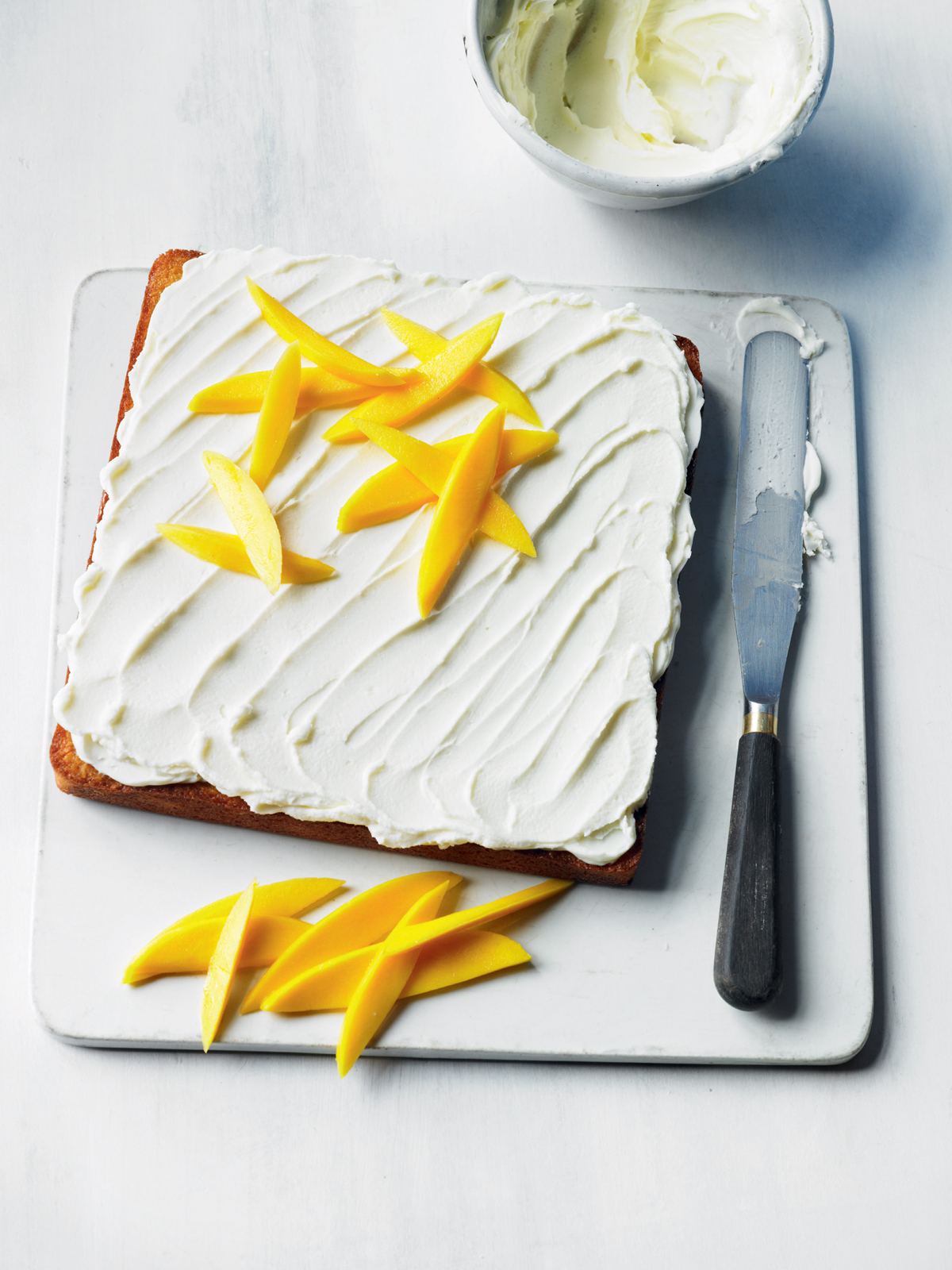
Tropical cake
Fresh pineapple is almost reason enough to head to sunnier climes – tangy slices dripping with juice can be one of the great culinary pleasures of a holiday in the tropics. The pineapples we get here can be a little dry by comparison. For this recipe it’s fine to use tinned pineapple, however, as it is more predictable in the amount of moisture and sweetness it contains. With the coconut and mango, this cake is a real celebration of tropical flavours.
Prep time: 25 minutes
Baking time: 45 minutes
Ready in: 2 hours
Serves: 8–12
250g (9oz) tinned pineapple (drained weight of a 432g tin)
200g (7oz) soft light brown sugar
225g (8oz) butter, softened, plus extra for greasing
3 eggs
125g (4½oz) self-raising flour, plus extra for dusting
100g (3½oz) desiccated coconut
1 large mango, peeled and sliced, to decorate
For the icing
250g (9oz) mascarpone
50g (2oz) icing sugar, sifted
23cm (9in) square cake tin with 5cm (2in) sides
Preheat the oven to 180°C (350°F), Gas mark 4, then butter the sides of the cake tin and dust with flour and line the base with a square of baking parchment.
Place the pineapple in a food processor and whiz for a minute or two until puréed, then put into a saucepan with the sugar. Set over a low heat and cook, stirring occasionally, for about 5 minutes or until the mixture turns a light brown colour. Then set aside and allow to cool.
Beat the cooled pineapple purée with the butter in a large bowl or in an electric food mixer. Whisk the eggs together in a small bowl for just a few seconds until mixed, then gradually add the eggs to the pineapple and butter mixture, beating continuously. Sift in the flour, add the coconut and fold in gently to combine.
Tip the batter into the prepared tin, then bake in the oven for about 45 minutes or until a skewer inserted into the centre of the cake comes out clean. Allow the cake to sit in the tin for about 20 minutes, then use a small, sharp knife to loosen the edges and carefully remove the cake from the tin before leaving on a wire rack to cool down completely.
To make the icing, whisk together the mascarpone and icing sugar, then spread over the cooled cake using a palette knife and finish by decorating with the sliced mango.
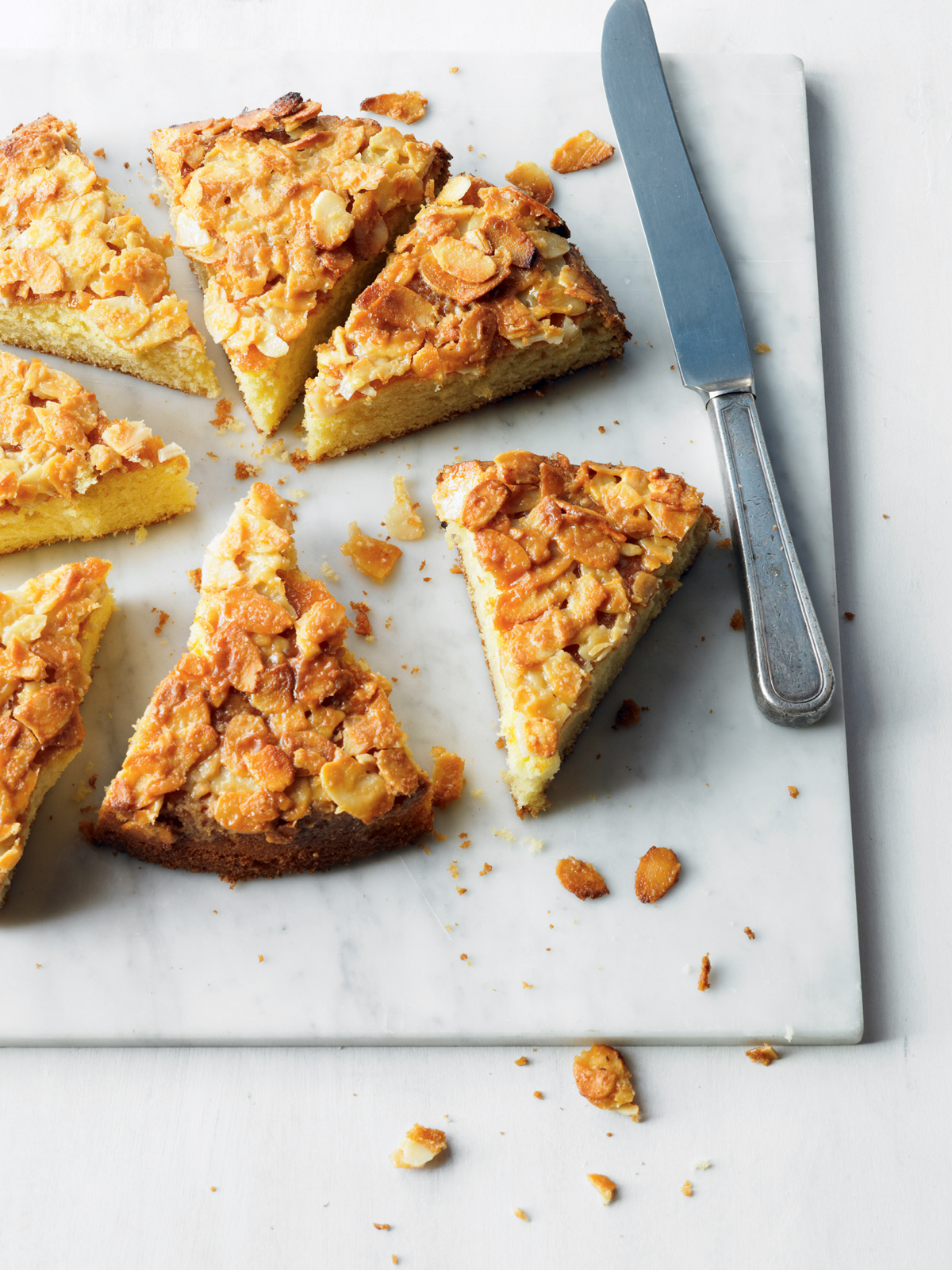
Toscatårta or Swedish almond cake
There is a banquet of baked Swedish treats, from kanelbullar (cinnamon buns) to kladdkaka (sticky chocolate cake), but one of the most well known is this relatively simple but absolutely divine almond cake – a light sponge topped with sweetened buttery almonds. Traditionally eaten at Christmas, it goes down just as well in the summer. Great on its own or with sweet, ripe strawberries.
Prep time: 15 minutes
Baking time: 45–50 minutes
Ready in: 1 hour 20 minutes
Serves: 8–10
3 eggs
150g (5oz) caster sugar
150g (5oz) plain flour, plus extra for dusting
1½ tsp baking powder
2 tsp vanilla extract
3 tbsp milk
75g (3oz) butter, melted, plus extra for greasing
For the topping
50g (2oz) butter
100g (3½oz) flaked almonds
50g (2oz) caster sugar
2 tsp plain flour
3 tbsp double or regular cream
1 tsp vanilla extract
23cm (9in) diameter spring-form or loose-bottomed cake tin with 6cm (2½in) sides
Preheat the oven to 180°C (350°F), Gas mark 4, then grease the base and sides of the cake tin with butter and dust with flour. If you’re using a spring-form tin, make sure the base is upside down, so there’s no lip and the cake can slide off easily when cooked.
Using a hand-held electric beater or an electric food mixer, whisk together the eggs and the sugar for 5–7 minutes or until thick and mousse-like.
Sift in the flour and baking powder and pour in the vanilla extract, milk and melted butter, then fold everything in until combined. Tip the mixture into the prepared tin and bake for 30–35 minutes or until a skewer inserted into the centre of the cake comes out moist but not totally clean, as the mixture will still need another 10 minutes of cooking. Increase the heat to 200°C (400°F), Gas mark 6.
Just before the 30–35 minutes are up, make the topping. Place the butter in a saucepan over a medium heat. When it has melted, add the remaining ingredients and bring to the boil, allowing the mixture to bubble away for 1 minute.
After the cake has been cooking for 30–35 minutes, remove it from the oven and spoon the almond mixture evenly over the top. Place it back in the oven and bake for about 10–15 minutes or until the topping is golden.
Leave to cool in the tin for 10 minutes. Then, using a small, sharp knife, loosen around the edges and carefully remove the sides of the tin before placing the cake (still on the base of the tin) on a wire rack to cool down fully.
To transfer to a plate, use a palette knife to loosen the bottom of the cake from the tin, then slide the knife under the cake and ease it onto the plate to serve.
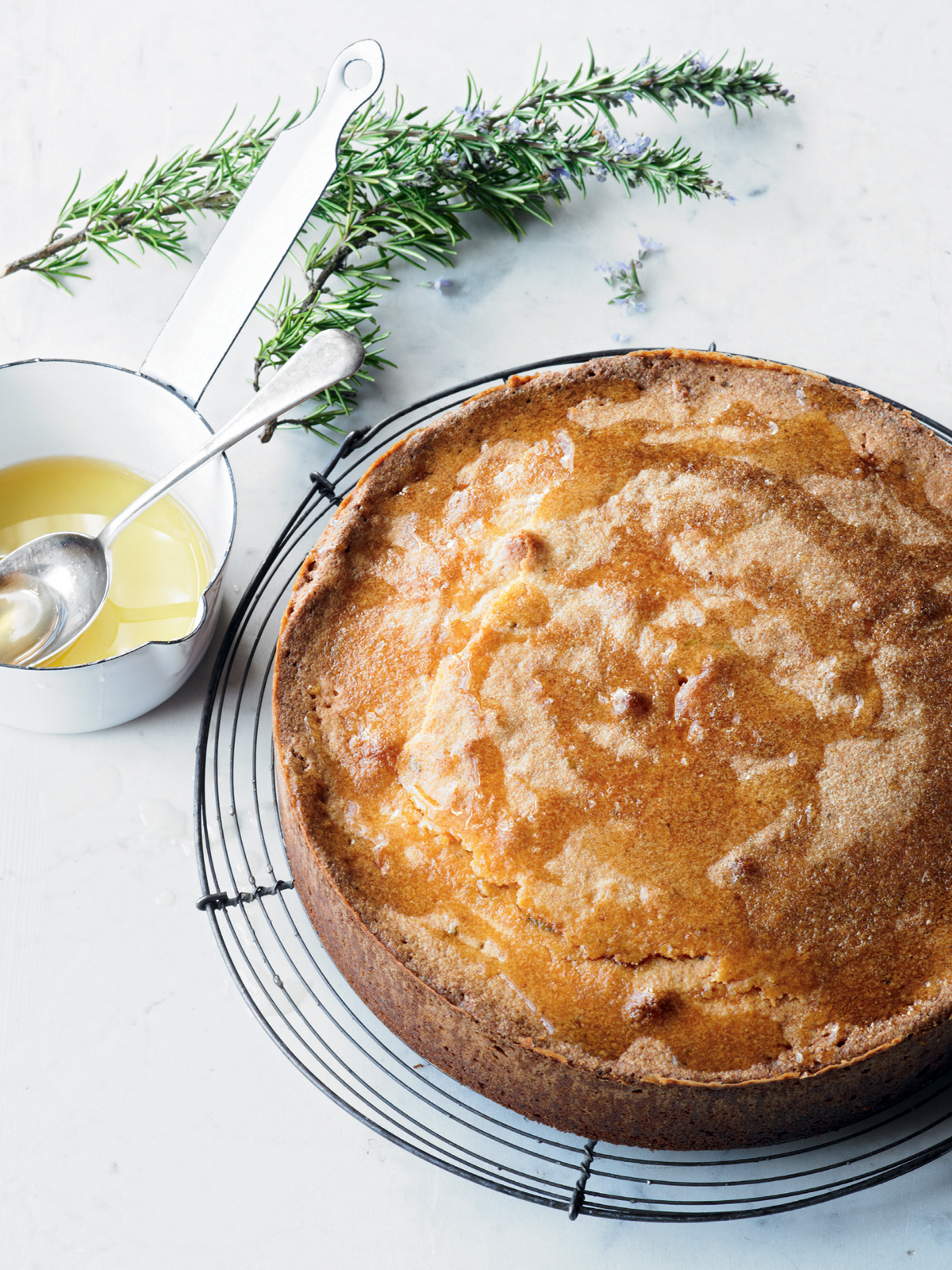
Lemon and rosemary polenta cake
The polenta and ground almonds in this cake mean that it’s already moist even before it’s smothered in a rosemary-lemon syrup as it emerges from the oven. The polenta gives a slight crunch too, which contrasts with the moist crumb. If you use a gluten-free baking powder, the cake will be totally gluten free. Stored in an airtight container, it will keep for a week or so.
Prep time: 30 minutes
Baking time: 1 hour 15 minutes–1 hour 25 minutes
Ready in: 2 hours 30 minutes
Serves: 10–12
225g (8oz) fine polenta
1 tsp baking powder
450g (1lb) butter, softened, plus extra for greasing
450g (1lb) caster sugar
450g (1lb) ground almonds
6 eggs
Finely grated zest of 2 lemons
3 tsp finely chopped rosemary leaves, plus sprigs of rosemary to decorate
For the syrup
Juice of 2 lemons
2 large sprigs of rosemary
100g (3½oz) caster sugar
25cm (10in) diameter cake tin with 6cm (2½in) sides
Preheat the oven to 170°C (325°F), Gas mark 3, then butter the sides of the cake tin and line the base with a disc of baking parchment.
Mix the polenta and baking powder together in a bowl. In a separate large bowl or in an electric food mixer, cream the butter until soft. Add the sugar and beat until the mixture is light and fluffy, then beat in the ground almonds.
Whisk the eggs together in a small bowl for a few seconds or just until mixed, then gradually add them to the creamed butter mixture, beating all the time. Add the lemon zest and chopped rosemary, then gently fold in the polenta and baking powder to combine.
Tip the batter into the prepared tin and bake on the lowest shelf of the oven for between 1 hour 15 minutes and 1 hour 25 minutes or until a skewer inserted into the centre of the cake comes out clean. The cake will cook to a deep golden-brown colour and may dip a little in the middle.
While the cake is cooking, make the syrup. Place all the ingredients in a saucepan, along with 50ml (2fl oz) of water. Place the saucepan on the hob, and bring to the boil, stirring to dissolve the sugar. Boil for 3–4 minutes until ever so slightly thickened, then remove from the heat and discard the rosemary sprigs.
When the cake is cooked, take it out of the oven and let it sit in the tin for 10 minutes. Loosen around the edges using a small, sharp knife, then carefully remove the cake from the tin and transfer to a serving plate. Reheat the syrup and pour over the cake, then leave the cake to cool down completely before serving. I like to decorate the centre with a few flowering sprigs of rosemary.
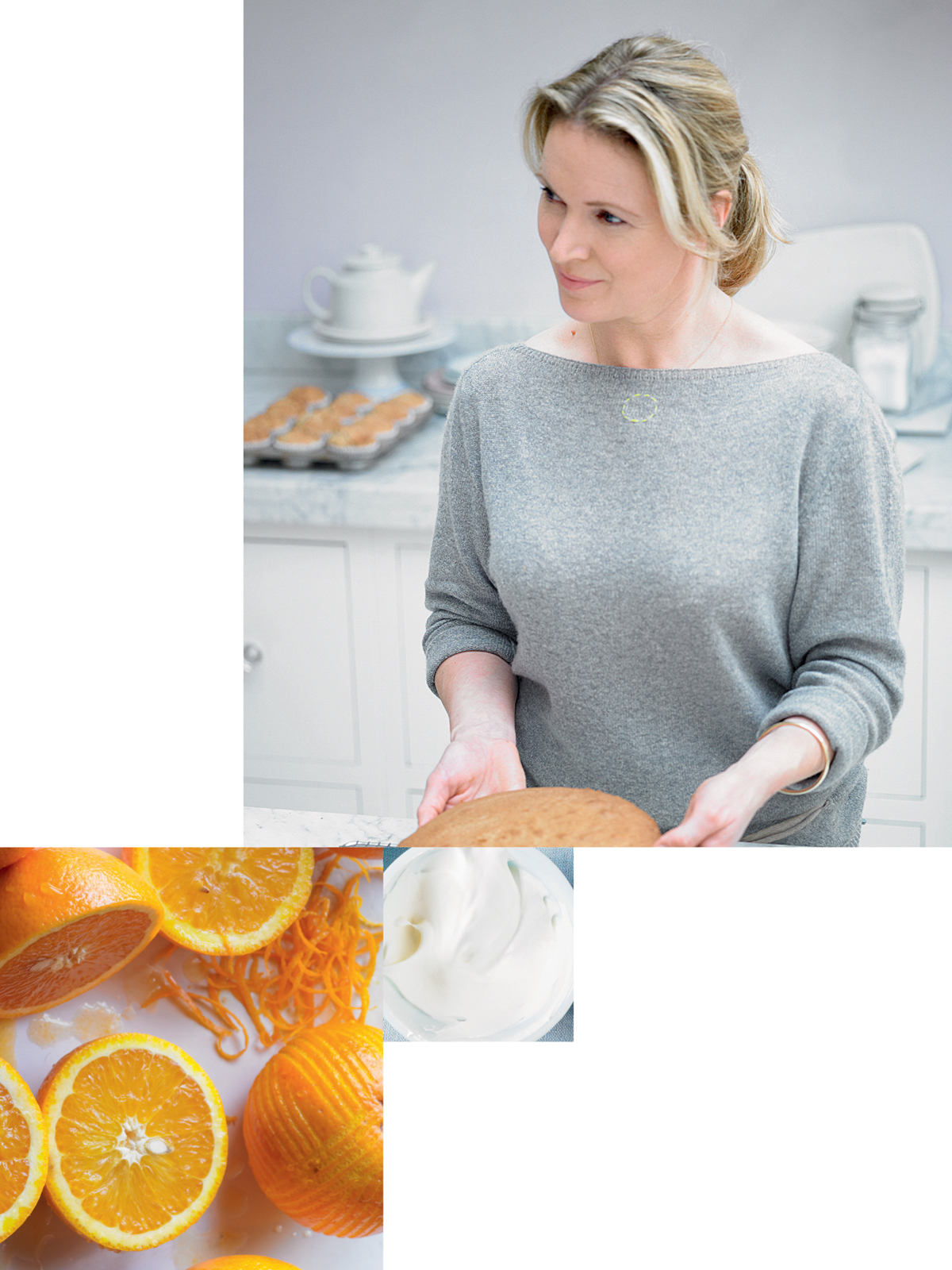
Orange sour-cream cake
Cakes made with sour cream are especially moist and have a very slight tang to them, which here is complemented by the bittersweet marmalade glaze. That tang is nicely accentuated by serving with spoonfuls of rich, thick crème fraîche. Kept covered, this cake will keep for 3–4 days.
Prep time: 10 minutes
Baking time: 40–50 minutes
Ready in: 1 hour 30 minutes
Serves: 6–8
200g (7oz) butter, softened, plus extra for greasing
200g (7oz) caster sugar
2 large eggs, beaten
Finely grated zest of 1 orange
200ml (7fl oz) sour cream
300g (11oz) plain flour
2 tsp baking powder
For the glaze
Juice of 1 orange
100g (3½oz) marmalade
20cm (8in) diameter cake tin with 6cm (2½ in) sides
Preheat the oven to 180°C (350°F), Gas mark 4, then butter the sides of the cake tin and line the base with a disc of baking parchment.
Cream the butter until soft in a large bowl or in an electric food mixer. Add the sugar and beat until the mixture is light and fluffy. Gradually add the eggs to the creamed butter mixture, beating all the time. Next beat in the orange zest and sour cream, then sift in the flour and baking powder and fold in to combine.
Tip the mixture into the prepared cake tin, then bake for 40–50 minutes or until a skewer inserted into the centre of the cake comes out clean.
While the cake is cooking, make the glaze. Place the orange juice and marmalade in a saucepan. About 5 minutes before the cake has finished cooking, place the pan on the hob and bring to the boil, stirring to dissolve the marmalade. Then remove from the heat.
When the cake is cooked, take it out of the oven and let it sit in the tin for just 5 minutes. Loosening around the edges using a small, sharp knife, carefully remove the cake from the tin, peeling away the baking parchment, then transfer to a serving plate.
Straight away pour the marmalade glaze over the cake (after reheating it if it has had a chance to cool down), then allow the cake to cool down fully while soaking up the syrup.

Sometimes we need a cake quickly. It could be a last-minute panic or when there is simply too much else to fit into the day to dedicate two hours to cake making. These fast recipes are for times like that. People often assume that if you have made a cake it has taken hours of work and you must be a genius, but that isn’t necessarily the case. Making a cake can take minutes rather than hours. Some of these faster cakes are made in the food processor, some are quite simple and some are not iced, but none of them take long to make. These cakes are not about delicate sugar craft or laborious preparation, they are smart recipes that make great-tasting cakes without cutting any corners.
02/ Fast
Muscovado Madeira cake
Winter breakfast muffins
Macadamia nut and lemon cakes
Lemongrass coconut cake
Fast cinnamon yoghurt cake
Raspberry and blueberry friands
Marzipan cake
Marzipan
Apple, oat and pecan bars
Raspberry and coconut squares
Crunchy peanut butter banana muffins
Upside-down peach and saffron cake
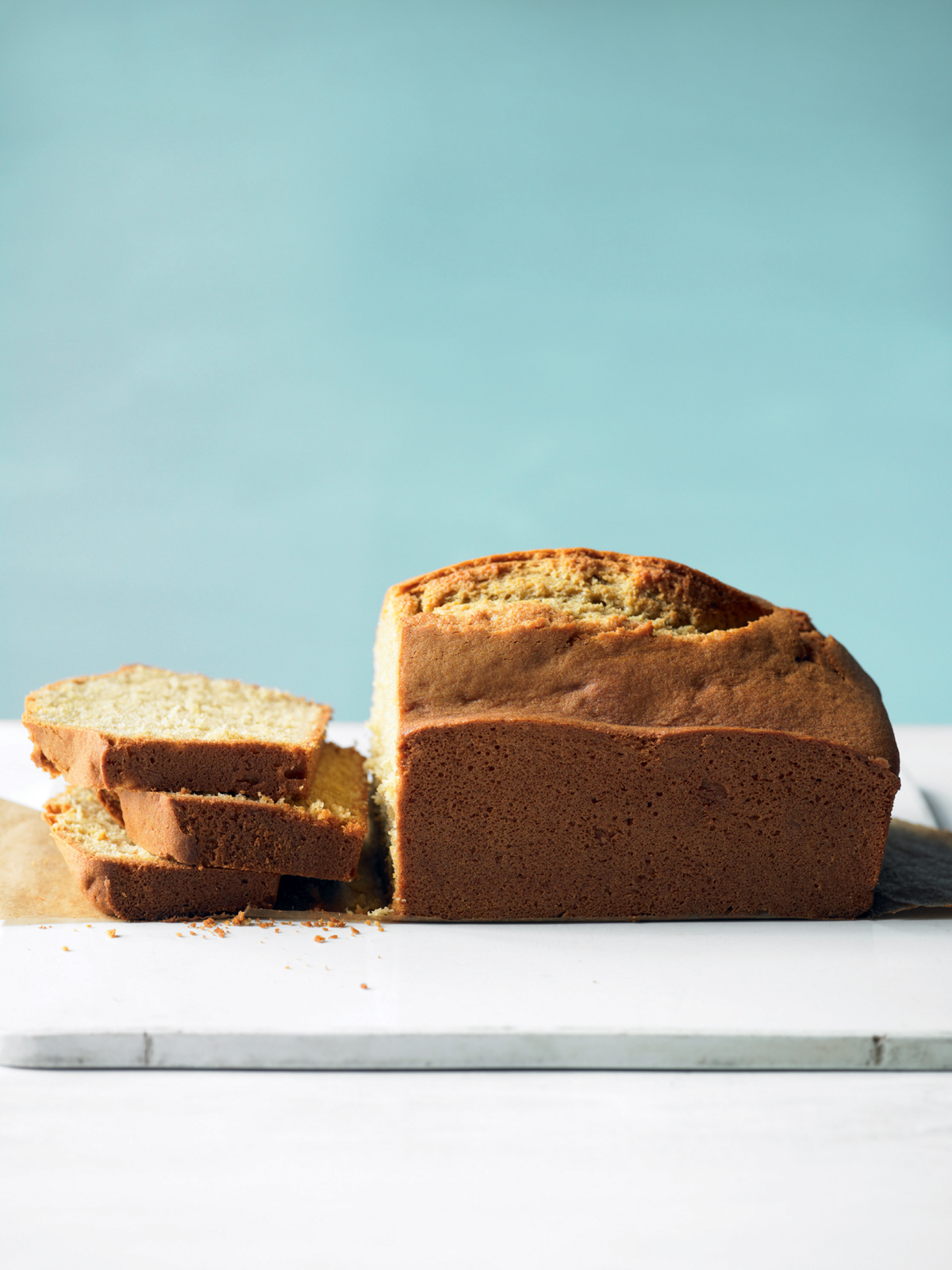
Muscovado Madeira cake
This classic English cake got its name from the sweet Madeira wine that it was traditionally served with back in the eighteenth century. Nowadays it’s more often eaten with tea, although if you do have a bottle of Madeira or dessert wine, it would go perfectly with either of those. This version is flavoured with the deep molasses sweetness of muscovado (soft brown) sugar. It’s a versatile recipe and you could include a handful of glace cherries, the finely grated zest of an orange or even a teaspoon of ground cinnamon if you like, adding these at the same time as the flour. (See also the additional variations.)
Prep time: 10 minutes
Baking time: 40–45 minutes
Ready in: 1 hour 15 minutes
Serves: 6–8
175g (6oz) butter, softened
175g (6oz) dark soft brown sugar
5 eggs
275g (10oz) self-raising flour
900g (2lb) loaf tin
Preheat the oven to 180°C (350°F), Gas mark 4, then line the base and sides of the loaf tin with baking parchment, with the paper coming above the sides of the tin to enable the cake to be lifted out easily.
Cream the butter until soft in a large bowl or in an electric food mixer. Add the sugar and beat until the mixture is light and fluffy.
Whisk the eggs together in a small bowl for just a few seconds until mixed, then gradually add them to the creamed butter mixture, beating all the time. Sift in the flour and fold in gently to combine. Tip the batter into the prepared tin and bake for 40–45 minutes or until a skewer inserted into the centre of the cake comes out clean.
Remove from the oven and allow to cool for 5 minutes. Carefully lift the cake out of the tin using the baking parchment, then peel away the paper and leave on a wire rack to finish cooling down.
Lemon Madeira cake
Make the cake as above, substituting caster sugar for the brown sugar and adding the finely grated zest of 1 lemon to the mixture with the eggs.
Coffee Madeira cake
Replace the brown sugar with caster sugar and mix in 3 tablespoons of coffee essence (Camp or Irel) with the eggs before adding to the batter.
Tip If any of this cake is left over, you could use it for making Cake pops.
Winter breakfast muffins
A hint of spice and a little ginger is sometimes all I need to perk me up on a frosty winter’s morning. Well, that and ten minutes standing by the Aga with a big cup of coffee! I like the plump juiciness of sultanas, but if you’d prefer you could use currants or raisins instead.
Prep time: 15 minutes
Baking time: 30 minutes
Ready in: 1 hour 15 minutes
Makes: 12 muffins
300g (11oz) plain flour
½ tsp bicarbonate of soda
½ tsp salt
2 tsp mixed spice
100g (3½oz) caster sugar
125g (4½oz) butter, cut into 1cm (½in) cubes
2 eggs
175ml (6fl oz) buttermilk
100g (3½oz) golden syrup
25g (1oz) stem ginger in syrup (drained weight), finely chopped
50g (2oz) sultanas
12-cup muffin tray and 12 muffin cases
Preheat the oven to 180°C (350°F), Gas mark 4, and line the muffin tray with the paper cases.
Sift the flour, bicarbonate of soda, salt and spice into a large bowl, then add the sugar and mix together. Add the butter and rub together with your fingertips until the mixture resembles breadcrumbs.
In another bowl, whisk together the eggs, buttermilk and golden syrup. Tip this into the flour mixture along with the chopped stem ginger and the sultanas, and beat until well mixed.
Divide the batter between the muffin cases, filling each about three-quarters full.
Bake the muffins for about 30 minutes or until well risen and springy to the touch. Allow the muffins to cool for about 5 minutes before removing them from the tin and placing on a wire rack to finish cooling.
Tip If you like, you could use some of the syrup from the stem-ginger jar to brush over the top of the muffins after they come out of the oven.
Macadamia nut and lemon cakes
This quick recipe uses a food processor to whiz up macadamia nuts before incorporating them into a lemon sponge mixture. The sharpness of the lemon contrasts so well with the rich and buttery nuts. If you can’t get hold of macadamias, you can replace them with ready-ground almonds for an even speedier cake, as the almonds won’t need whizzing in the food processor.
Prep time: 20 minutes
Baking time: 15–18 minutes
Ready in: 50 minutes
Makes: 12 cakes
50g (2oz) macadamia nuts
150g (5oz) self-raising flour, sifted
150g (5oz) caster sugar
3 eggs
Finely grated zest of 2 lemons
100g (3½oz) butter, melted
For the icing
200g (7oz) lemon curd (to make it yourself,
25g (1oz) macadamia nuts (or almonds), lightly toasted (see the tip) and roughly chopped
12-cup muffin tray and 12 muffin cases
Preheat the oven to 180°C (350°F), Gas mark 4, and line the muffin tray with the paper cases.
Place the macadamia nuts in a food processor and whiz for a minute or two until fairly fine. Add the rest of the ingredients and pulse just until combined. Divide the batter between the muffin cases, filling each up to three-quarters full.
Bake for 15–18 minutes or until the cakes spring back lightly to the touch. Take out of the oven and allow to cool for 5 minutes, then remove from the tin and place on a wire rack to cool down fully.
When the cupcakes are cool, spread generously with lemon curd, then scatter over the toasted macadamia nuts.
Tip To toast nuts, either scatter them over a baking tray in a single layer and toast them in the oven (preheated to 180°C/350°F/Gas mark 4) for 4–5 minutes or until golden brown, or place them in a frying pan and toast over a medium–low heat for a similar length of time. In either case, the nuts need to be shaken every so often to prevent them burning on one side.







